| ZX-81 Software Scene |
ONE OF the questions which users of the ZX-81 often ask concerns the use of high-resolution graphics on the ZX-81. A new software-only package has just been produced which will provide eight hi-res commands with a screen grid resolution of 192 x 256.
The routines in the package will allow you to draw circles and lines on the screen, as well as defining your own characters. It provides most of the hi-res capabilities of the Spectrum, except for colour.
The program is slow compared to the Spectrum and it can take up to half an hour to draw complicated shapes and patterns. When you have constructed a screenful of graphics you can save the results, to be loaded later.
Like so many packages of its kind, its manual seems to have been written by the programmer. Very often a person who knows a good deal about a program is not the best person to write the manual to explain things to someone who knows nothing of the subject.
The manual is pocket-sized and gives a brief explanation of the hi-res commands available. It does not provide sufficient examples of the commands and half the manual is devoted to blank paper, where the user can make notes. It would have been better if more instructions were included in those spaces.
The 16K ZX-81 high resolution package can be obtained from most computer branches of John Menzies. It costs £5.95.
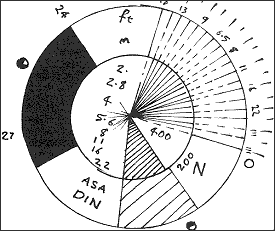
SPECIALIST computer applications are difficult to learn about but when such a program is produced it is usually written by experts and is good at doing its job. That is true of Protim, a photographic process timer for the 16K ZX-81. A developer can enter the processes and timings necessary for the developing of a photograph. When the data has been set up, option one on the program main menu can be selected to start the timing of a process.
The timer is displayed as a camera with a digital clock set into the centre. The time decreases on the display at approximately five-second intervals. When the time is up a banner saying "process complete" is scrolled on and off the screen until a return to the menu is requested by the user.
There are two disadvantages to the program. The first is in the timing, as the clock can be set using only multiples of five seconds. The other is that the developer will not be able to leave the screen display to do something else.
An application of this kind would have been better applied to a computer which has sound capabilities, such as the Spectrum.
The computer could then inform the user of the end of the process with a buzz or a click.
Apart from those small quibbles the program performs its task well and should be useful to a photographer with a ZX-81.
Protim can be obtained from Photosoft, Hampshire. It costs £5.95.
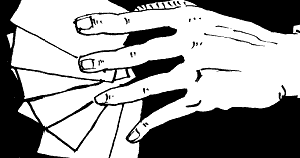
MANUFACTURERS of software, especially those new to the scene, still insist on producing traditional card games. Eights, for the 16K ZX-81, is yet another example of the attitude.
The game is usually played by two human opponents. Seven cards are dealt to each player who must pick up and discard cards during the game in an effort to collect, and play, a series of four eights. The winner is the one who manages to find all the eights and the final score is determined by the number of cards left in the loser's hand.
In the ZX-81 game the computer takes the part of your opponent in a series of games. To win a series you must accumulate 100 points or more. The computer plays a good game and we were not able to beat it, although we were very close with two eights in our hand.
In view of the difficulty of beating the machine it would have been a good idea to include several levels of play, if memory space allowed. Unfortunately the computer seems too intelligent.
It is as if the author had set out to prove that the computer could be made to play without human error. What should really be on the programmer's mind is to achieve a balancing effect to give the human some hope of winning. If that is not done, there is no point in playing.
Eights is well-presented but lacks imagination. That is unfortunate as the program is efficient and well-structured. A game, however, does not sell on its code structure.
Eights can be obtained from Hardy Software, Cardiff. It costs £4.
| Spectrum Software Scene |
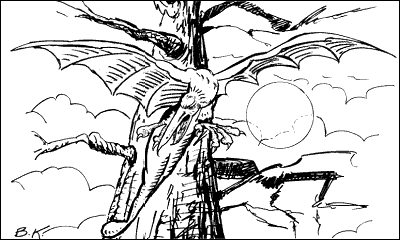
MELBOURNE HOUSE has taken its time in releasing Terror-Daktil 4D for the 48K Spectrum. The reason may be that the company wanted to produce a program which is up to the standard of The Hobbit but that adventure is a difficult act to follow.
The game displays a three-dimensional landscape over which the terror-daktils fly in their attempts to destroy you. Your cannon and cannonballs are ready but you have to hit the creatures in the body if you are going to score.
The bodies of the birds are difficult to hit when they are in the distance as they look like over-sized space invaders.
The best part of the game is when the birds swoop from formation and dive at you and your thimble-sized cannon.
Once the action starts you will have your hands full with birds swooping from nowhere. We were surprised to discover that you can hit a bird even if your cannon shot is too high in its trajectory. That effect is a mark against the game but is necessary as the cannon will not move very far up or down.
The three-dimensional effects are interesting but at the beginning of the game is a three-dimensional sequence which is unnecessary and tedious to watch.
When you start to play the demonstration mode, which is more than a minute long, it is very dramatic and picturesque but it can become monotonous if you want to get into the game.
Terror-Daktil 4D is available from Melbourne House, London. It costs £6.95.
YOU MUST flour-bomb the ingredients of your new cake into the mixing bowl if you want to serve dinner in Cookie, a new game for the 16K Spectrum. Your job is to make a cake but the ingredients will jump out of the pantry and try and avoid you. You must put them into the bowl before they knock you into the mix or they fall into the dustbins on either side.
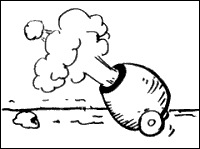
As with all Ultimate products so far, the graphics are of arcade and cartoon quality. The game concept is novel but it is easy to lose interest after you have played through a few levels of those evil ingredients.
When you have been playing the game for a short time you will begin to see that it is easier to play than you first thought. We found that by staying above the mixing bowl we could bomb through several levels of the game before being hit by a pike bone. The game could have been made more difficult at the start so that players do not get used to it so quickly.
Cookie is on first impressions everything that you could ask for in a game. The graphics and sound are superb, the concept is original, and the presentation is professional. The customer will be drawn to it because of those aspects but may feel cheated after two playing sessions.
Cookie costs £5.50 and can be obtained from Ultimate Play the Game, Leicestershire.
IMAGINE has gained a reputation for producing games with original concepts and Zip Zap, for the 48K Spectrum, is no exception. The game centres on a robot which is the last of its race. It must collect power cells which are used with a time transporter which will extract it from its present dangerous situation and you into the next level.
It would be an understatement to say that the graphics and sound are superb. Unlike previous Imagine games, Zip Zap has a depth of concept which should keep you playing for hours.
The controls of the robot are difficult to understand at the start, until you realise that the left button will make it arc left and the right key will make it arc right.
Only when you take your finger off the key will it stop arcing. That means that you could describe a complete circle if you want to reverse to avoid the aliens which will hinder your movement at each level.
The aliens change on each level and we calculate that there are 32 types of alien which you must encounter before you return to the first type on level 33.
That means you will have to do plenty of playing to discover all of the alien types and that is what makes the game so compulsive.
Zip Zap is an excellent arcade-quality game. It can be obtained from Imagine Software, Liverpool. It costs £5.50.
A FEW MONTHS ago Your Computer published a flight simulation program for the 16K Spectrum. Protek has since taken over the program and released it under the title of Airliner.
The program is very good considering it is written mostly in Basic. The display shows all the flight instruments and there is no view through the aircraft windscreen. The only outside view is when you are preparing to land and the level indicator disappears to display a rough 3D representation of the approaching runway.
That effectively means that you are flying blind, and looking at the instrument panel all the time becomes tedious.
The program is excellent in other respects. It allows the pilot to define wind speed anddirection and even to decide where the aircraft should be situated when the simulation starts. The instructions include an example giving the factors to put the aircraft on a path straight for the runway.
It is not simple to put down the aircraft from that position but by using the co-ordinates you will have some idea of what happens in a crash landing.
While the program is well crash-proofed, some extra care should have been taken where numeric inputs are made by the pilot. Numeric variables are used and if an incorrect key is pressed the program will crash.
When you are asked whether you want another attempt you must make sure that you put in 'Y' or 'YES' or the computer will stop. There is no room for errors in that department.
Airliner is available from Protek Computing Ltd, Edinburgh. It costs £5.95.
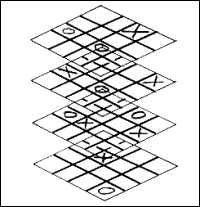
NOUGHTS AND CROSSES is better played on a piece of paper and not with a computer. Artic Computing has realised that and gone one better than the usual three-by-three board in 3D Quadracube for the 16K Spectrum.
The game has a four-by-four board but it is also has four slices, or levels, on which to play. The slices are displayed in high-resolution during play and as each block is filled by a player's piece it is coloured either blue or red instead of the usual noughts and crosses. That is something you cannot do on paper.
The program gives the option of playing with the Spectrum as a partner or with another human. The computer is difficult to beat as it has a better memory for numbers and can cope better with the extra dimension. Our best score was a thrashing in 17 moves and the worst was another thrashing in seven moves.
3D Quadracube has more of a hold on the player than simple noughts and crosses or connect four. It is an irritating game as you start by knowing that the computer has a better chance of winning than any player. That does not detract from the game, however, as it makes it all the more challenging.
3D Quadracube can be obtained from Artic Computing, Hull. It costs £4.95.
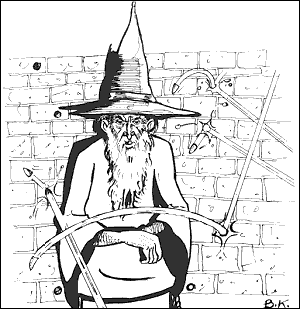
YOU ARE invited to spend an evening with the evil wizard Cinslair and his many denizens in a new game for the 48K Spectrum, Wizard's Warriors. You must shoot the blue, yellow and white warriors as you progress through the crypts of his castle and confront the wizard at the abyss between this world and Hell.
The game sounds fascinating in theory but the Abersoft implementation is less than perfect. When the game is first loaded you have the option either of reading through or skipping the instructions. One press of an incorrect key and you will be left with no idea of the control keys or how to play the game. There are no instructions on the cassette insert, despite the fact that many players often need a crib sheet to refer to if their fingers stray from the correct keys.
The instructions are displayed on three screens before play. That is possible because each screen has been tightly packed with words. It makes comprehension very difficult.
The last page of instructions shows the keyboard configuration. It can be easily missed if you keep your finger on the key too long when changing from one page to the next. The keys have been made too sensitive and the only way to return to the instructions is by re-loading the game.
The Wizard's Warriors costs £4.95.